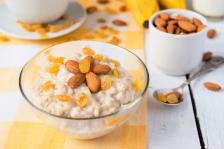Multi-grain vs. Whole-grain
Whole grains are great for you. But things aren’t always what they appear.

Being the nutrition-conscious type that you are, you have probably taken this message to heart and are doing your best to eat more whole grains. But if you are confusing “multi-grain” products with “whole-grain” products, you may still be falling short of the mark.
The Whole Truth About Whole Grains
Whole grain products contain all the parts of the grain: the germ, which is rich in essential fatty acids and b-vitamins; the endosperm, which is mostly starch; and the bran, which, of course, is high in fiber. In products made with refined grains, on the other hand, most of the germ and bran have been removed, leaving the starchy endosperm, which is the least nutritious part of the grain.
And here’s something I was surprised to learn: Whole grains, much like the Nutrition Diva herself—are greater than the sum of their parts. You might think that you could take some refined flour, add some bran, essential fatty acids, and b-vitamins, and end up with the equivalent of a whole grain. Not so!
The health benefits that you get from eating actual whole grains add up to more than what you’d get out of eating the equivalent amount of fiber or any of the other nutrients we know they contain. Researchers suspect that the whole grains also contain phytochemicals that we don’t know about, and these compounds are responsible for some of the good effects. Somehow, the whole package as it occurs in nature offers something we can’t quite replicate in the food lab.
Whole Grain Imposters
So, how do you know whether a grain is whole or not?
With foods like oatmeal, bulgur wheat, brown rice, popcorn, or quinoa, you’re always getting the whole grain—and these are all great foods to include in your diet. It gets trickier with foods like breads, crackers, pasta, and tortillas, where the grains have been milled into flour. Then, it can be a little harder to tell whether you’re dealing with whole grains or not.
It doesn’t make it any easier that manufacturers go out of their way to make their products look and sound healthy, even when they aren’t. They use molasses or food coloring to mimic the darker color of whole-grains. They add ingredients that create a dense, chewy texture. They use virtuous-sounding words like “stone-ground,” “100% wheat,” or “multi-grain.” None of these things are a reliable indicator of whole grains.
A “multi-grain” bread, for example, could be made out of several types of refined grains. Or, more likely, it’s made with lots of refined white flour and small amounts of other whole grains. I’m sorry to be the one to tell you that those multi-grain doughnuts are probably not the nutritional powerhouses you’ve been telling yourself they are.
Examine the Ingredient List
Your best bet is to ignore most of the words on the package and zero in on the ingredient list. Look specifically for the word “whole” right before name of the grain, as in, “whole wheat,” or “whole oats.” Keep in mind that the ingredients listed first are the ones that make up the bulk of the product.
For advice on how to get better results when baking with whole grains, check out this handy Quick Tip of mine. I also have a Quick Tip to get more nutriitional value from grains.
Now that you know how to tell an authentic whole grain from an imposter, remember to aim for at least three servings a day. If you’d like to learn more about whole grains and how they keep you healthy, see the show notes for a link to a really good fact sheet from the International Food Information Council.
Click here to get my delicious recipe for quinoa slad with pecans and cranberries, and head over here for a way to turn leftover bread into gourmet crostini.
These tips are provided for your information and entertainment and are not intended as medical advice. Because everyone is different, please work with your health professional to determine what’s just right for you.
If you have a nutrition question, send an email to nutrition@quickanddirtytips.comcreate new email or leave me a voice mail at 206-203-1438. Or, you can connect with me and other Nutrition Diva fans on Facebook.
Have a great day and eat something good for me!
RESOURCES:
Fact sheet on health benefits of eating whole grains
My recipe for Quinoa Salad with Pecans and Dried Cranberries
The Nutrition Diva Page on Facebook
Oatmeal image courtesy of Shutterstock

